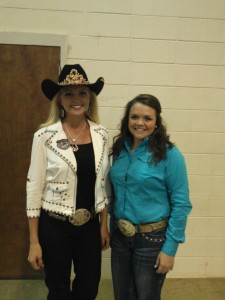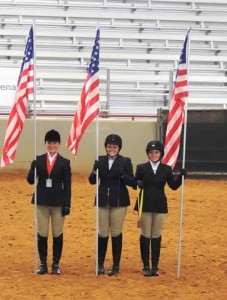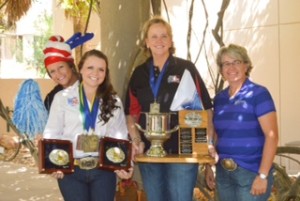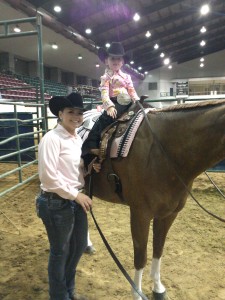 Kalee McCann, 19 years old, is the President of the American Quarter Horse Youth Association. She is currently a freshman at East Central Community College in Decatur, Mississippi. She will be transferring to Texas A & M in August to continue her studies in chemistry, and will ride on A & M’s equestrian team. She hopes to go on to dental school and specialize in pediatric orthodontics. “Most of my family hates going to the dentist, but I have always enjoyed going. I’ve had good teeth my whole life!”
Kalee McCann, 19 years old, is the President of the American Quarter Horse Youth Association. She is currently a freshman at East Central Community College in Decatur, Mississippi. She will be transferring to Texas A & M in August to continue her studies in chemistry, and will ride on A & M’s equestrian team. She hopes to go on to dental school and specialize in pediatric orthodontics. “Most of my family hates going to the dentist, but I have always enjoyed going. I’ve had good teeth my whole life!”
Kalee is from Sebastopol, Mississippi, which, she says, is very small. Her family lives on a farm on the outskirts of town, right beside her grandparents. Her little brother Wyatt, 16, is a roper, so they have a roping arena. The family has 150 Longhorn cows and “plenty of horses” and a big barn on about 75 acres. Kalee explains that when Longhorns are born, they have little knobs where the horns will start growing in about two months. “We want our cows to keep their horns,” she says. In fact, when cows pass away, she cleans the skulls, decorates them with mosaic glass, and sells them.
 Kalee and Wyatt’s father, Joey McCann, got them started with horses. He had ridden while he was growing up and had spent time breaking colts for a trainer in Sebastopol. He competes at shows and rodeos alongside his kids. Their mom did some trail riding in her younger days, and, says Kalee, she’s very supportive. “She’s a good horse show mom. She keeps us together, keeps us organized, and gets our clothes ready!” The family travels with a living-quarters stock trailer that is very versatile. They can haul cows if they need to.
Kalee and Wyatt’s father, Joey McCann, got them started with horses. He had ridden while he was growing up and had spent time breaking colts for a trainer in Sebastopol. He competes at shows and rodeos alongside his kids. Their mom did some trail riding in her younger days, and, says Kalee, she’s very supportive. “She’s a good horse show mom. She keeps us together, keeps us organized, and gets our clothes ready!” The family travels with a living-quarters stock trailer that is very versatile. They can haul cows if they need to.
Joey McCann is a self-employed auctioneer. He does horse sales frequently, but his main auctioneering job is car auctions. He does 5 to 6 sales a week and travels all throughout Mississippi and Louisiana. “He usually works Tuesday through Friday,” says Kalee. “When he gets home, we load up and go to shows.” People that don’t have anything to do with horses don’t realize what a wonderful family activity showing is. Going camping with family is fun, but having the extra dimension of caring for horses gives everyone a common goal and encourages responsibility.
 Kalee’s brother Wyatt used to show Quarter Horses, but when he became a teenager he took up roping. In team-roping he does both heading and heeling, and he also competes in breakaway and tie-down calf-roping. The family used to breed Quarter Horses, but, says Kalee, “We sold out of that. But we still have our stud and our last baby, who is now a four-year-old mare.”
Kalee’s brother Wyatt used to show Quarter Horses, but when he became a teenager he took up roping. In team-roping he does both heading and heeling, and he also competes in breakaway and tie-down calf-roping. The family used to breed Quarter Horses, but, says Kalee, “We sold out of that. But we still have our stud and our last baby, who is now a four-year-old mare.”
At Texas A&M, a Division 1 school, Kalee will ride for the National Collegiate Equestrian Association. She acknowledges the difficulties that the NCEA is having in its effort to stay an NCAA sport. Part of the problem is that spectators for women’s equestrian events are usually limited to friends and family of the competitors. There isn’t much income from ticket sales or concession stand sales. Newcomers have a hard time understanding what they are seeing. Nevertheless, Kalee says, Texas A&M is committed to equestrian sports: the university just built an $80 million equestrian facility for the English and Western teams. “It is absolutely unreal,” she says.
 Kalee points out that Intercollegiate Horse Show Association teams are usually found at Division 2 and 3 schools. However, during the year IHSA and NCEA teams often compete against each other. Host schools provide the mounts, and competitors find out which horses they have to ride just before the competition, in a random drawing. “You only have four minutes to prepare and get to know the horse. There is a home school advantage, of course. But everybody gets the same advantage at some point.” Reining and horsemanship comprise the Western competition. In horsemanship, the rider and horse perform a pattern and the judges look for smooth transitions, cooperation, and harmony. In reining, says Kalee, it’s mainly the horse that’s being judged: how well does the horse negotiate the pattern? She says that most horses do maneuvers better to one side than the other: discovering an unknown horse’s stiff side is one of the things a competitor has to find out in the four minutes before the test.
Kalee points out that Intercollegiate Horse Show Association teams are usually found at Division 2 and 3 schools. However, during the year IHSA and NCEA teams often compete against each other. Host schools provide the mounts, and competitors find out which horses they have to ride just before the competition, in a random drawing. “You only have four minutes to prepare and get to know the horse. There is a home school advantage, of course. But everybody gets the same advantage at some point.” Reining and horsemanship comprise the Western competition. In horsemanship, the rider and horse perform a pattern and the judges look for smooth transitions, cooperation, and harmony. In reining, says Kalee, it’s mainly the horse that’s being judged: how well does the horse negotiate the pattern? She says that most horses do maneuvers better to one side than the other: discovering an unknown horse’s stiff side is one of the things a competitor has to find out in the four minutes before the test.
Since all IHSA and NCEA riding is catch-riding, Kalee’s show horse Browser will stay at home. “The only way you can bring your own horse is to donate him to the college.” Kalee has owned Browser for five years. “He’s right at 16 hands,” she says. “He’s a solid bay and his registered name is Gotta Get Hot. He’s really laid back. Not much gets to him. When other horses spook, he just looks over at them!” Kalee says that her personality and Browser’s personality really mesh. “He reminds me of my little brother!” Browser started off as a jumping horse, but he couldn’t do the high jumps, so Kalee turned him into an all-around horse, which means that Browser shows in both Western and English. “Browser doesn’t compete in reining, because he doesn’t spin around very fast,” she says.
Before Browser, Kalee owned a bald-faced sorrel Quarter Horse named Jack. At their last show together, Jack hurt his leg…and that Christmas her parents gave her Browser. “We actually bought him from a cell phone video. My dad was very nervous about buying a horse from a picture on a tiny screen!”
Kaylee was in the top four of the state last year and qualified for Nationals. But she also made the 2014 Youth World Cup team for the AQHA, and chose to do that competition instead, because the World Cup is only held every two years, and in another two years she would no longer be eligible. Team USA won the gold, and Kaylee won two individual gold medals, both in equitation. She received two bronze medals in reining and two Top Ten placings in cutting.
The 2014 AQHA Youth World Cup took place in College Station, Texas, at a local equestrian complex near Texas A&M. Quarter Horse owners all over the country donated horses just for the competition. Past World Cup competitors tried out the horses to find out which ones would be suitable.
“I wish the 2014 Cup had been held in a foreign country. But I still had a lot of fun!” Kalee says. There were 16 countries represented: Australia, Austria, Belgium, Canada, Denmark, France, Germany, Ireland, Israel, Italy, Luxembourg, New Zealand, Norway, Switzerland, the United Kingdom and the United States. “The German team was very strong,” says Kalee. “They came in second. They were very close to us in points. They were extremely disciplined!”
“It’s much like the Olympics: we have the parade of countries. It was very humbling to do that for our country. There were only 10 people on our team, and only five were riders. The vice president of the AQHYA, also from Mississippi, was our team leader. We stayed in one of the dorms at Texas A&M, with all the other competitors from other countries. It was cool to see how involved they were with the same things we are.” Kalee says that the European countries may not have as many Quarter Horse shows as the United States does, but the ones they do have are very big. Some of the European Quarter Horse competitors will fly over and show in the United States, much as Americans will fly to Germany to experience dressage at its finest, or fly to England to compete at the Badminton and Burghley Three-Day Events. Since the World Cup, Kalee says that she’s seen several of the people showing over here that she had met at the World Cup.
Kalee speaks highly of the Youth Excellence Conference, organized by the AQHA and held every year in Amarillo, Texas, home of the AQHA. In 2014 the AQHA combined the YES Conference with the World Cup, so that the youth could attend the competition.
The YES conference emphasizes leadership and lasts three days. Attendees are members of AQHA affiliates. “You split up into different groups with people you don’t know and do team-building exercises led by AQHYA officers,” says Kalee. There are seminars, dinners, receptions, and a dance. The YES young people are the future of the AQHA: tomorrow’s riders, trainers, and breeders. The networking is great, says Kalee. “It makes going to horse shows a lot more enjoyable—you aren’t competing against strangers; you’re meeting up with friends.”
During YES, AQHYA officers and directors are elected. Two years ago, Kalee was a regional director for Region 9, which covers Mississippi, Louisiana, Arkansas, Tennessee, and Alabama. Last year Kalee was elected AQHYA Vice President. This year she ran for President and won.
“The President’s job is fun, but also educational,” says Kalee. “You work closely with people who are involved in the AQHA.” Kalee is in charge of two committees, membership and scholarship fund raising. The scholarships include the $8,000 Woodruff Scholarship and the Wrangler Aspire award for outstanding youth. She explains that one application makes you eligible for all awards. The scholarship committee decides which scholarship the youth is competing for. However, Kalee says, the decisions are made by AQHA adults, since the AQHYA officers are eligible for consideration. The AQHYA President and the regional directors come up with new scholarship ideas, and hand out information to encourage youth to join the organization and apply for aid. The membership committee makes presentations at schools and meetings of the FFA and 4H. Kalee says that the committee spreads the word about the AQHA and the scholarship program at many horse shows. The American Quarter Horse Foundation gave out $319,000 in scholarships to youth in 2014.
Kalee is already showing in the National Cutting Horse Association, the National Reining Horse Association, and the AQHA. She hopes to continue showing horses in the future as an amateur. “You name it, I’ve done it! Way down the road, I want my kids to do it too!”
Kalee says, “My parents have worked hard and gone way out of their way to allow my brother and me to do what we want to do. It’s given me a foundation for the next chapter of my life…going to college, moving away from home. But, since I’ll be tied in with horses on the equestrian team, it’ll be a little like home. And the discipline of caring for and showing horses will make dental school easy!”





